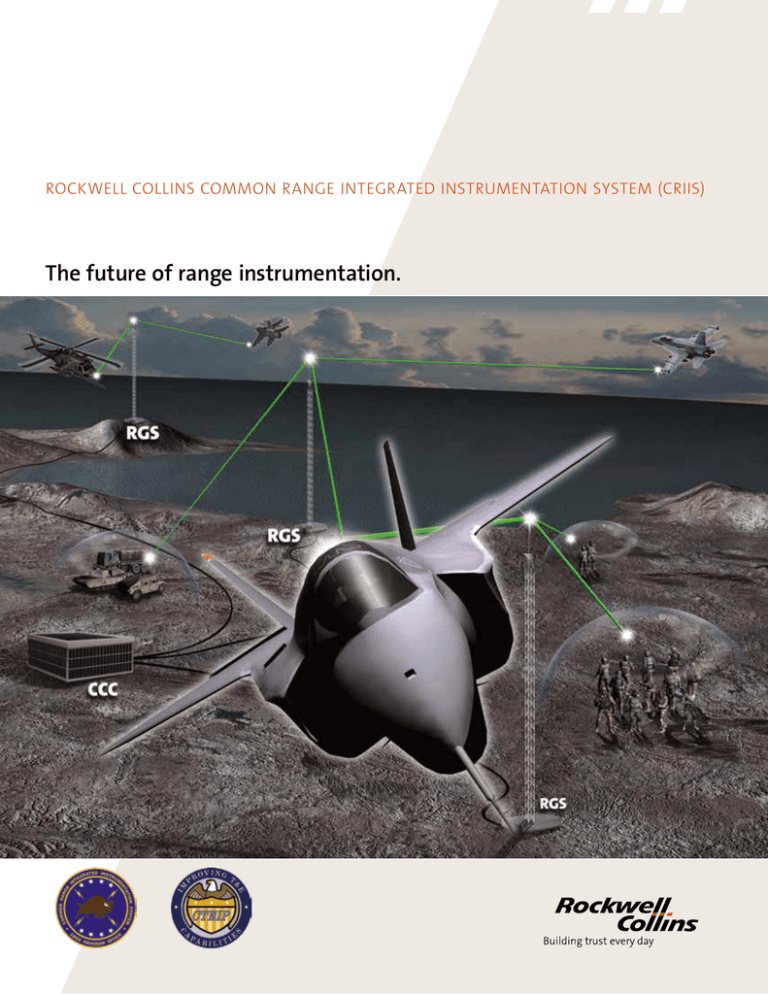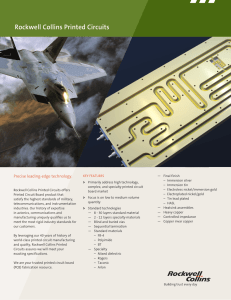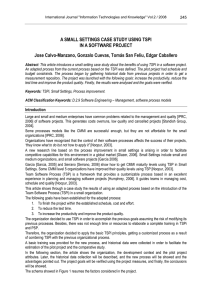
ROCKWELL COLLINS Common Range Integrated Instrumentation System (CRIIS)
The future of range instrumentation.
A proven solution for accurately testing
next-generation weapon systems.
The speed and accuracy of today’s advanced weapons systems
have outstripped the ability of prior-generation Advanced Range
Data System (ARDS)-based testing ranges to provide accurate
performance data.
Rockwell Collins has assembled a team of innovators to introduce
the Common Range Integrated Instrumentation System (CRIIS).
CRIIS fulfills a critical DoD requirement to provide Time, Space and
Position Information (TSPI) and systems evaluation data to support
testing for a variety of current and next-generation platforms.
CRIIS consists of three “Increments” of capability. The first to be
developed and fielded, called Increment 2, will replace the aging
ARDS participant and ground infrastructure, and will provide
significantly greater capabilities than ARDS. Increment 2 includes
pod and internal mount air participant packages, plus all ground
and security infrastructure enhancements. Increments 1 and 3 are
options that follow the Increment 2 effort. Increment 1 is for use on
ships, helicopters, unmanned aerial vehicles (UAVs), ground vehicles
and dismounted soldiers. Increment 3 has significantly more
accurate non-positional TSPI, for very high dynamic aircraft.
By giving range managers the flexiblity to mix any combination
of these platforms in a given mission, CRIIS gives developers and
military leaders the ability to ensure that next-generation systems
can be developed and deployed to the field faster and with a greater
degree of confidence.
CRIIS. The one solution that can scale to any level
of capability a range or exercise requires.
CRIIS is much more than a replacement instrumentation system
for test ranges. Steps have been taken to realize the U.S. DoD’s
vision of a common solution for test and training instrumentation
which delivers the capability of communicating with the P5Combat Training System’s (P5-CTS) Advanced Data Link (ADL)
equipped pod and range infrastructure, without hardware
changes.
CRIIS is designed with growth capability to support additional
training messages and real-time kill notifications. This means that
the CRIIS pod or internal mount system you test with today can
seamlessly interoperate with the P5-ADL training environment
tomorrow. The CRIIS ground infrastructure also contains a TENAcompliant interface for sharing data with other test or training
systems or ranges.
What you need, when you need it.
CRIIS’s flexible, open architecture means that once it is installed,
the range users can quickly scale it to any level of testing capability
they need. This enables one range, and one CRIIS to satisfy the
individual or combined needs of any mix of participants
from high-speed aircraft, helicopters, ships, ground vehicles
and dismounted troops.
Efficient, accurate TSPI testing for all domains.
Rockwell Collins CRIIS not only delivers the most accurate TSPI
information, it utilizes the most advanced Global Differential GPS
tracking to deliver the highest degree of accuracy regardless of
flight dynamics or distance from a reference receiver. CRIIS uses
operationally proven TSPI sensors, with significant software legacy,
to reduce risk and increase reliability. Utilizing the most advanced
GPS augmentation technologies, CRIIS is proven to reliably meet
the 50 cm positioning accuracy across all dynamics. For offshore
operations, only the range of the data link connection limits the
system’s accuracy.
From the system control center, to the remote ground stations
and on to the vehicle-mounted pods and internal mount packages,
CRIIS uses common, modular components within an open
architecture to create an easily installable, reliable, and supportable
system today, while supporting a low risk upgrade path for both
future Increment 1 and 3 implementation. All system interfaces
are 100% industry standard.
The net result is whether you are testing air, sea, land or personnelbased platforms, CRIIS can deliver the performance your test range
needs today, while ensuring ease of future growth including the
ability to support additional training messages and real-time
kill notifications.
Highly flexible network connectivity for multiple platforms.
In today’s rapidly advancing world of continuous capability
enhancement, test range operators know that the abilities of a data
collection system are critical to the efficient evaluation of system
performance.
Based upon Rockwell Collins’ recognized Joint Tactical Radio System
(JTRS) leadership and proven Software Communication Architecture
(SCA) foundations, it is capable of hosting the ad hoc CRIIS Test
Waveform (CTW), plus future training waveforms.
The High Throughput Data Link (HTDL), part of the Increment 2
solution, provides enhanced data transfer flexibility, control, and
increased data capacity. It includes removable Type I encryption
security. It also contains, as does every CRIIS data link on every
platform, built-in Type III encryption.
The relay capability extends high-rate communications well
offshore, with the added benefit of providing 50 cm TSPI
accuracy to distant participants. The dismounted soldier and
vehicle configurations use similar COTS data links, along with an
operationally-proven common networking layer, as demonstrated
at White Sands Missile Range.
The HTDL has been demonstrated by multiple flight tests, assuring
connectivity in low and high dynamic environments.
Scalability and flexibility for efficient evaluation
of new solutions and tactics.
Because CRIIS is scalable in performance, number and type
of users, a mission can be planned to include any mixture of
participant types. This ensures the realistic testing of complex
and interactive systems more efficiently and effectively so nextgeneration solutions and tactics can be deployed with a higher
degree of confidence.
All CRIIS participant package configurations, from the dismounted
soldier, to low-dynamic vehicle, to high-dynamic aircraft, are
interoperable on a single range. Positional accuracy scales from
less than 1 meter for the soldier to less than 50 cm for the aircraft
are achievable with greater reliability – even during high dynamic
maneuvers.
The data link frequencies are selectable to minimize interference
between mission participants. Many of the CRIIS components
are modular and common between participant packages, and
even with the ground subsystem. For example, the internal
components of the pod and internal mount configurations are
identical, to reduce logistic burden and enhance the ability to deal
with obsolescence.
The open, flexible architecture required for this high level of
modularity and scalability has been designed into CRIIS from
the start. Future upgrades are more easily accomplished as new
systems with advanced capabilities are developed. CRIIS is not just
the ideal range solution for today, but it’s created to be ready for
evolving range needs for decades to come.
Building trust every day.
Rockwell Collins delivers smart communication and aviation
electronic solutions to customers worldwide. Backed by a global
network of service and support, we stand committed to putting
technology and practical innovation to work for you whenever and
wherever you need us. In this way, working together, we build trust.
Every day.
For more information, contact:
Rockwell Collins
400 Collins Road NE
Cedar Rapids, Iowa 52498
+1.800.321.2223
+1.319.295.5100
fax: +1.319.378.1172
email: learnmore@rockwellcollins.com
www.rockwellcollins.com
147-1195-002 08/14 © 2014 Rockwell Collins. All rights reserved.
All logos, trademarks or service marks used herein are the property of their respective owners.






